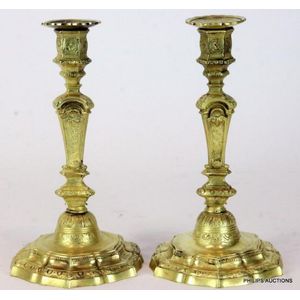French Neoclassical Candlesticks, 19th Century
A pair of French ormolu and bronze candlesticks, late 19th century. In the neoclassical taste with beaded detail, each with spreading sconce, three-sided tapering pilaster column decorated with diaper motifs and fleur-de-lys, raised on scalloped base with rais-de-coeur decoration, height 24 cm
You must be a subscriber, and be logged in to view price and dealer details.
Subscribe Now to view actual auction price for this item
When you subscribe, you have the option of setting the currency in which to display prices to $Au, $US, $NZ or Stg.
This item has been sold, and the description, image and price are for reference purposes only.
- Sconce - A light attached to a wall. Originally a candle holder that is attached to a wall with an ornamental bracket and sometimes with a reflective back plate, but now applied to an electric light that has been inspired by that design.
In recent times the word has also come into use to desribe the candle holders on a candelabra. - Bronze - An alloy of copper and tin, traditionally in the proportions of about 9 parts of copper to 1 part of tin.
The discovery of bronze in Western Asia in the 4th century enabled people to create metal objects which were superior to those previoulsy possible because of its strength and hardness, and it has been used throughout the world for weapons, coins, tools, statuary and other decorative items.
It is very fluid in a molten state, and its hardness, strength when set, and non-corrosive properties makes it most suitable for casting sculpture. - Diaper Motif - The diaper motif is a repeating geometric pattern in decorative arts that consists of small diamond or lozenge shapes arranged in a grid. The pattern is often used as a background or border on textiles, ceramics, metalwork, and other decorative items. It can be found in a variety of cultures and historical periods, and is often used in formal or ornamental designs. The name "diaper" comes from the pattern's resemblance to the criss-crossed fabric of a baby's diaper.
- Ormolu - Ormolu was popular with French craftsmen in the 18th and 19th century for ornamental fittings for furniture, clocks and other decorative items. True ormolu is gilt bronze, that is bronze that has been coated with gold using a mercury amalgam. Due to the health risks associated with using mercury, this method of creating ormolu was discontinued in France in the 1830s. A substitute was developed consisting of about 75% copper and 25% zinc, however it was inferior to the bronze version. It was often lacquered to prevent it tarnishing.
This item has been included into following indexes:
-
candlesticks, material
- gilt and bronze 259
- ormolu and bronze 181
